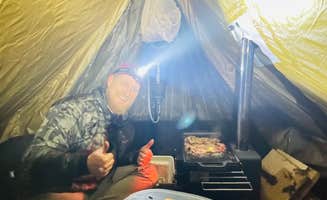Dispersed camping near Columbia, Kentucky provides primitive experiences in the Daniel Boone National Forest region. The area's limestone terrain creates unique camping conditions alongside creeks and river access points. Several free backcountry sites exist within a 50-mile radius of Columbia, offering alternatives to developed campgrounds during peak seasons.
What to do
**Creek exploration: At Trace Branch Dispersed - Rock Creek Road, visitors can enjoy waterside activities. "We took our portable firepit and sat by the creek for a beautiful evening," notes camper Pam B. The location provides direct creek access for wading during summer months.
**Wildlife observation: Winter camping provides unique wildlife viewing opportunities in the area. Frozen water features create different landscapes. According to Matthew H., "The entire river was frozen over and ponds were frozen too," creating distinctive winter camping conditions not available in warmer months.
**Stargazing: The remote locations create excellent dark sky conditions. Limited light pollution allows for exceptional night sky viewing, particularly during new moon phases. Winter months provide clearer atmospheric conditions for constellation identification.
What campers like
**Natural quiet: First Creek Dispersed Camping — Mammoth Cave National Park offers exceptional seclusion. Camper Shelly S. notes, "You should have some beautiful star gazing opportunities and some wildlife interactions." The location's distance from developed areas contributes to its quiet environment.
**Seasonal variations: The landscape changes dramatically throughout the year. "If you go early enough in the season you will see some awesome rock formations. Once all the foliage fills in its not as picturesque," explains one visitor about the First Creek area. Spring camping provides different views than summer or fall visits.
**Vehicle accessibility: Rock Creek Road sites can be reached with standard vehicles in good weather. The gravel access road remains passable during dry conditions but requires caution after precipitation. Winter access requires appropriate vehicles.
What you should know
**Navigation challenges: Trail markers at some locations require supplemental navigation tools. Maps from ranger stations or visitor centers provide more reliable information than on-site markings. "A map is very useful for distances and trail directions because the markers are not always where they are supposed to be," advises Shelly S.
**Winter preparation: Cold weather camping requires specialized gear at these sites. Ground conditions often freeze, making tent setup more difficult. According to one camper at Trace Branch Dispersed, "You can only set up your tent on the designated tent pad, luckily we had heavy duty stakes that could get through the ground."
**Site availability: No reservation system exists for these areas. Weekends during summer months see increased usage, while weekdays provide better site selection. Holiday periods experience the highest visitor numbers.
Tips for camping with families
**Safety considerations: The hike to some dispersed sites presents challenges for younger children. Parents should assess trail difficulty in advance. "First Camp Dispersed tent sites are an enjoyable hike down into the First Creek creek bed of Green River...Realize of course water = snakes and take precautions," notes an experienced camper.
**Light management: Complete darkness can be concerning for children unaccustomed to backcountry conditions. Additional light sources beyond headlamps provide comfort. Multiple campers note the exceptional darkness, with one stating, "It gets DARK here!"
**Wildlife education: Prepare children for potential wildlife encounters before arrival. Teaching proper food storage techniques involves children in safety protocols. One visitor recommends, "take precautions with your food, it's a long hike back up that hill!"
Tips from RVers
**Site limitations: RV camping options are severely restricted at these dispersed locations. The access roads do not accommodate larger vehicles or trailers. Tent camping remains the primary accommodation option at these sites.
**Parking alternatives: Park RVs at designated trailheads for access to hike-in sites. Overnight parking regulations vary by location and require verification with ranger stations. No hookups or services are available at any parking areas.
**Supply management: "Tote in your water or filtration system and everything you need," advises a regular visitor to the area. RV campers must be entirely self-contained when using these areas as no services exist for waste disposal or water refill.


